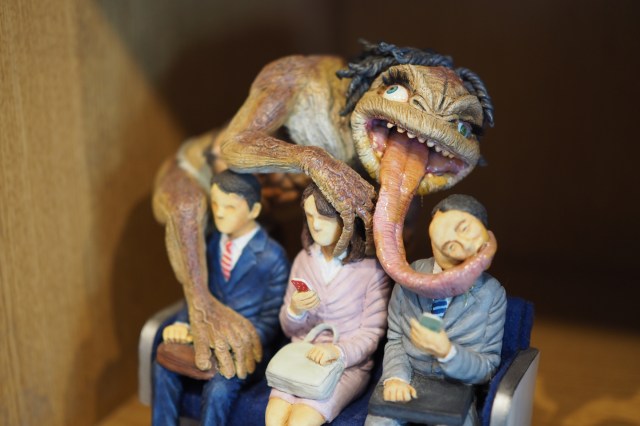
Finally, a return to normalcy.
The Seto Inland Sea area is famous for both its pristine natural beauty and its thriving art community. And one part of this community is the Yokai Museum on Shodo Island which boasts a collection of over 800 statues and figures representing traditional Japanese monsters known as yokai.
▼ 800 is even more impressive when you see how big some are
However, unlike other exhibitions of yokai, this museum is the only one of its kind that specializes in “modern yokai.” According to the Yokai Museum, yokai served many purposes such as a boogeyman to stop kids from doing bad things or simply as a form of ghost-story entertainment.
▼ Don’t go to sleep with candles lit, or the candle yokai will come
But one other purposes was as a way to explain the unexplainable in everyday occurrences. For example, if I dropped my toast and it landed with the butter side down, I could curse my own bad luck, or I could just write it off as the toast-flipping yokai doing their thing. In a way this provides a sort of an irrational yet cathartic closure to the incident allowing me to move on with my life.
▼ A bunch of people making noise outside your home? Maybe, or maybe it’s just one yokai with seven mouths.
This purpose could certainly be used in the modern times as well. If some jerk cuts me off on the street, I could get angry at him, or just come to the conclusion that he was possessed by a cut-off yokai. Not much I can do about a cut-off yokai, so I might as well just let the matter be.
▼ Same goes for dog poop left on the street or… I don’t know what going on with those other two.
In other words, just as they did in the past, yokai can act as agents of peace and tranquility, helping us make sense of the senseless by making light of it. This is the spirit behind modern yokai and the Yokai Sculpture Competition which is returning next year after a prolonged 5-year break.
This art show, which has drawn works from artists all over Japan and as far away as Hong Kong and Taiwan, encourages people to come up with their own modern yokai. Entries will be judged both on their artistic merit as well as the creativity of the yokai’s backstory.
▼ I kind of want to go just so I can get this one’s backstory.
The grand-prize-winning piece will receive 300,000 yen (US$2,000) and awards will also be given out in 10 other categories such as the Children’s Dream Award which is handed out to works by kids in elementary school or younger. Works are judged by a panel of judges including artists in the fields of manga, sculpture, and animation.
Entries will be accepted from 15 December, 2022 to 14 January, 2023 which should give all you artists out there a little time to put a sculpture together. There appear to be no restrictions on who can apply, but you’d probably have to make your own way out to Japan to receive any award you might win. Even if it doesn’t win a prize, approved entries will be added to the Yokai Museum’s rotating displays which is an honor in itself.
▼ Even while not on display, the closet shelves lined with yokai are still a spectacle.
Outside the award season too, the Yokai Museum is certainly a fun place to check out when in the area. Shodo Island is just a three-hour ferry ride from Kobe making it accessible from Kansai as an easy overnight, or possibly even one day trip.
▼ And the fact that they have a bar ought to seal the deal
We’ll be looking forward to seeing who wins in next year’s awards. In the meantime, I’ll be deciding whether to sculpt a yokai that’s like a giant head that eats guardrails from the side of the roads or some kind of golem that tears the handles off public toilets.
Museum information
Yokai Museum / 妖怪美術館
Address: Kagawa-ken, Shozo-gun, Tonosho-cho, Ko 398
香川県小豆郡土庄町甲398
Website
Source, images: PR Times
● Want to hear about SoraNews24’s latest articles as soon as they’re published? Follow us on Facebook and Twitter!

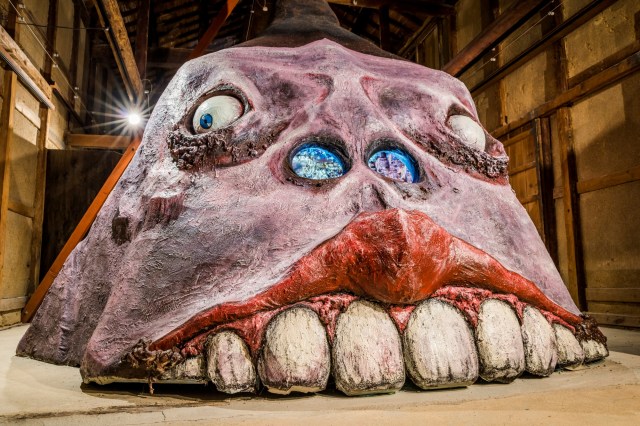
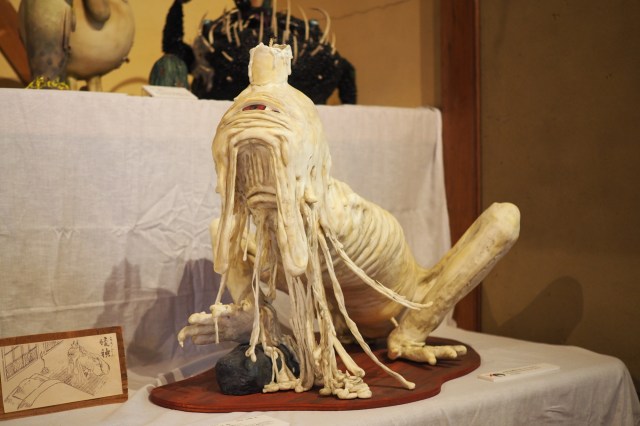
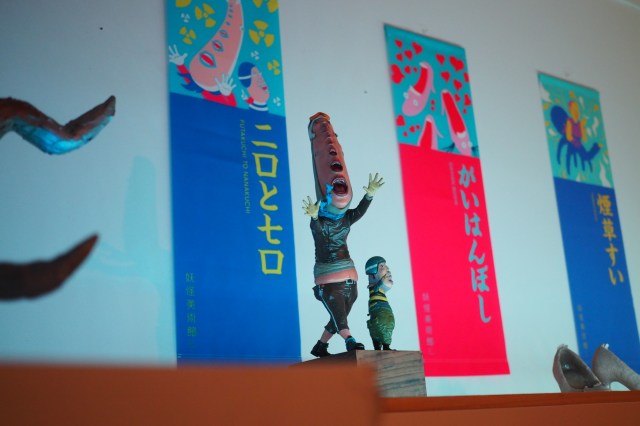

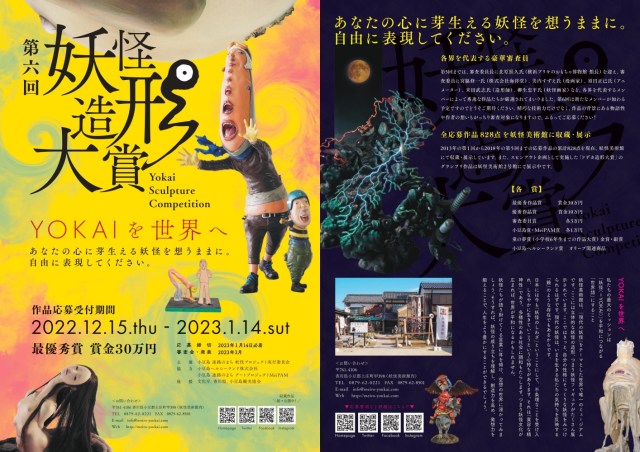

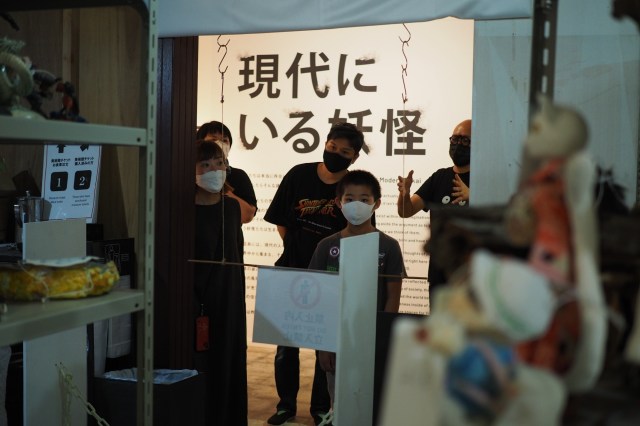
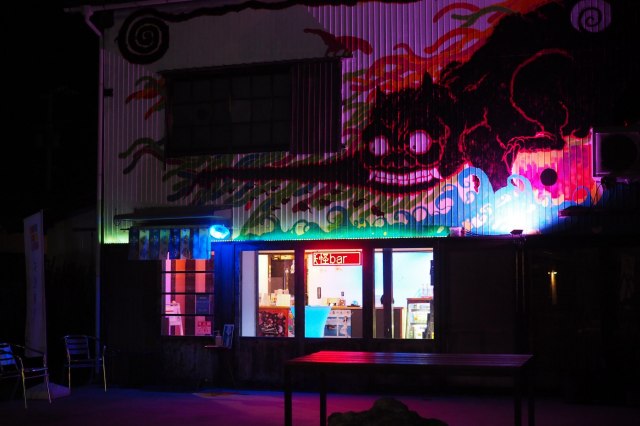
 Get your chills on the rails with Kyoto’s Ghost Train 【Video】
Get your chills on the rails with Kyoto’s Ghost Train 【Video】 Kyoto’s 100 Demons yokai monster parade returns!
Kyoto’s 100 Demons yokai monster parade returns! Shiba Inu dressed up as Japanese yokai achieve new level of cute and spooky
Shiba Inu dressed up as Japanese yokai achieve new level of cute and spooky Tempura yokai are here to terrorize and tantalize capsule toy fans【Photos】
Tempura yokai are here to terrorize and tantalize capsule toy fans【Photos】 The most unusual ATM in Japan? Banking with yokai spirits who want to know your PIN
The most unusual ATM in Japan? Banking with yokai spirits who want to know your PIN Demon Slayer: Kimetsu no Yaiba gets new roller coaster attractions and food at Universal Studios Japan
Demon Slayer: Kimetsu no Yaiba gets new roller coaster attractions and food at Universal Studios Japan How to order snacks on a Shinkansen bullet train in Japan
How to order snacks on a Shinkansen bullet train in Japan New samurai glasses are Japan’s latest weird must-have souvenir
New samurai glasses are Japan’s latest weird must-have souvenir New Nintendo Lego kit is a beautiful piece of moving pixel art of Mario and Yoshi【Photos】
New Nintendo Lego kit is a beautiful piece of moving pixel art of Mario and Yoshi【Photos】 Nintendo history you can feel – Super NES, N64, and GameCube controllers become capsule toys
Nintendo history you can feel – Super NES, N64, and GameCube controllers become capsule toys High-fashion Totoro cuddle purse is like an elegant stroll in the forest【Photos】
High-fashion Totoro cuddle purse is like an elegant stroll in the forest【Photos】 Yabai Ramen: What makes this Japanese ramen so dangerous?
Yabai Ramen: What makes this Japanese ramen so dangerous? Studio Ghibli hair accessories keep your style tidy with help from Kiki, Moro, Calcifer, and more
Studio Ghibli hair accessories keep your style tidy with help from Kiki, Moro, Calcifer, and more Japan’s new difficult-to-drink-from beer glass protects your liver, but it’s a brutal experience
Japan’s new difficult-to-drink-from beer glass protects your liver, but it’s a brutal experience Doraemon found buried at sea as scene from 1993 anime becomes real life【Photos】
Doraemon found buried at sea as scene from 1993 anime becomes real life【Photos】 Hello, cosmetics! Clinique teams up with Hello Kitty this summer for first-time collaboration
Hello, cosmetics! Clinique teams up with Hello Kitty this summer for first-time collaboration “The most Delicious Cup Noodle in history” – Japan’s French Cup Noodle wins our heart【Taste test】
“The most Delicious Cup Noodle in history” – Japan’s French Cup Noodle wins our heart【Taste test】 Starbucks releases a cute Frappuccino and Unicorn Cake…but not in Japan
Starbucks releases a cute Frappuccino and Unicorn Cake…but not in Japan Kyoto Tower mascot termination reveals dark side behind cute Japanese characters
Kyoto Tower mascot termination reveals dark side behind cute Japanese characters McDonald’s Japan’s Soft Twist Tower: A phantom ice cream only sold at select branches
McDonald’s Japan’s Soft Twist Tower: A phantom ice cream only sold at select branches Finally! Nintendo Japan expands Switch 8-bit controller sales to everybody, Online member or not
Finally! Nintendo Japan expands Switch 8-bit controller sales to everybody, Online member or not Japanese government wants to build luxury resorts in all national parks for foreign tourists
Japanese government wants to build luxury resorts in all national parks for foreign tourists To combat declining birth rate, Japan to begin offering “Breeding Visas” to foreigners
To combat declining birth rate, Japan to begin offering “Breeding Visas” to foreigners 10 things you should buy at 7-Eleven in Japan
10 things you should buy at 7-Eleven in Japan Studio Ghibli releases anime heroine cosplay dresses that are super comfy to wear
Studio Ghibli releases anime heroine cosplay dresses that are super comfy to wear Woman charged for driving suitcase without a license in Osaka
Woman charged for driving suitcase without a license in Osaka Studio Ghibli unveils My Neighbour Totoro miniature house model
Studio Ghibli unveils My Neighbour Totoro miniature house model Kyoto experiencing problems with foreign tourists not paying for bus fares, but not on purpose
Kyoto experiencing problems with foreign tourists not paying for bus fares, but not on purpose Fighting mild hunger with a Japanese soda that turns into jelly in the stomach【Taste test】
Fighting mild hunger with a Japanese soda that turns into jelly in the stomach【Taste test】 Studio Ghibli’s Howl’s Moving Castle tapestry unveiled in Japan for first time
Studio Ghibli’s Howl’s Moving Castle tapestry unveiled in Japan for first time McDonald’s new Happy Meals offer up cute and practical Sanrio lifestyle goods
McDonald’s new Happy Meals offer up cute and practical Sanrio lifestyle goods Sales of Japan’s most convenient train ticket/shopping payment cards suspended indefinitely
Sales of Japan’s most convenient train ticket/shopping payment cards suspended indefinitely Sold-out Studio Ghibli desktop humidifiers are back so Totoro can help you through the dry season
Sold-out Studio Ghibli desktop humidifiers are back so Totoro can help you through the dry season Japanese government to make first change to romanization spelling rules since the 1950s
Japanese government to make first change to romanization spelling rules since the 1950s Foreigner’s request for help in Tokyo makes us sad for the state of society
Foreigner’s request for help in Tokyo makes us sad for the state of society Ghibli founders Toshio Suzuki and Hayao Miyazaki contribute to Japanese whisky Totoro label design
Ghibli founders Toshio Suzuki and Hayao Miyazaki contribute to Japanese whisky Totoro label design Tokyo’s most famous Starbucks is closed
Tokyo’s most famous Starbucks is closed Princesses, fruits, and blacksmiths: Study reveals the 30 most unusual family names in Japan
Princesses, fruits, and blacksmiths: Study reveals the 30 most unusual family names in Japan Yokai Train in Kyoto offers a fun and fright-filled ride of ghosts and demons
Yokai Train in Kyoto offers a fun and fright-filled ride of ghosts and demons Paramount Pictures project asks artists to reimagine Ninja Turtles as kappa
Paramount Pictures project asks artists to reimagine Ninja Turtles as kappa Add a Japanese anime twist to your Halloween costume with unisex kimono cosplay
Add a Japanese anime twist to your Halloween costume with unisex kimono cosplay Despite getting Star Wars VII on launch day, Japan will get the eighth installment a month late
Despite getting Star Wars VII on launch day, Japan will get the eighth installment a month late Japanese yokai starts appearing on Twitter to prevent the spread of COVID-19
Japanese yokai starts appearing on Twitter to prevent the spread of COVID-19 Fukuoka man arrested for licking the ear of a female stranger he fancied
Fukuoka man arrested for licking the ear of a female stranger he fancied Attack on Titan’s gigantic monsters set to terrorize this year’s Sapporo Snow Festival 【Photos】
Attack on Titan’s gigantic monsters set to terrorize this year’s Sapporo Snow Festival 【Photos】 Yo-Kai Watches selling out everywhere, resourceful kids and parents make their own instead
Yo-Kai Watches selling out everywhere, resourceful kids and parents make their own instead Horror manga artist Junji Ito shares terrifying drawing of Amabie, the epidemic-protector yokai
Horror manga artist Junji Ito shares terrifying drawing of Amabie, the epidemic-protector yokai We visit Kaiyodo Kappa Museum: dedicated to a yokai that loves cucumbers and human souls
We visit Kaiyodo Kappa Museum: dedicated to a yokai that loves cucumbers and human souls Moms vs. demon slayers — Japanese grade schoolers asked: “Who do you respect most and why?”
Moms vs. demon slayers — Japanese grade schoolers asked: “Who do you respect most and why?” What’s cuter than a cat? A cat with a cat-mask on
What’s cuter than a cat? A cat with a cat-mask on Newest Hello Kitty collab features Kitty-chan cosplaying as supernatural protector against plague
Newest Hello Kitty collab features Kitty-chan cosplaying as supernatural protector against plague Big, drunk and furry—Everything you need to know about tanuki (plus a song about their balls!)
Big, drunk and furry—Everything you need to know about tanuki (plus a song about their balls!) Male grooming brand creates bizarre manga, features cloth demon reincarnated as a body wipe
Male grooming brand creates bizarre manga, features cloth demon reincarnated as a body wipe
Leave a Reply